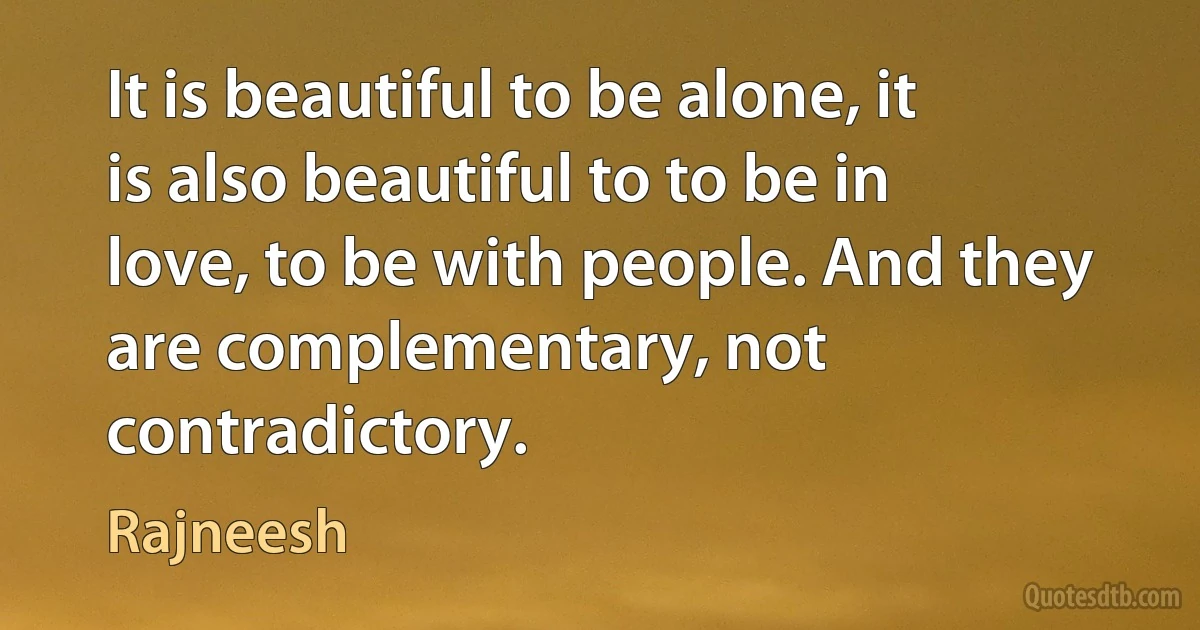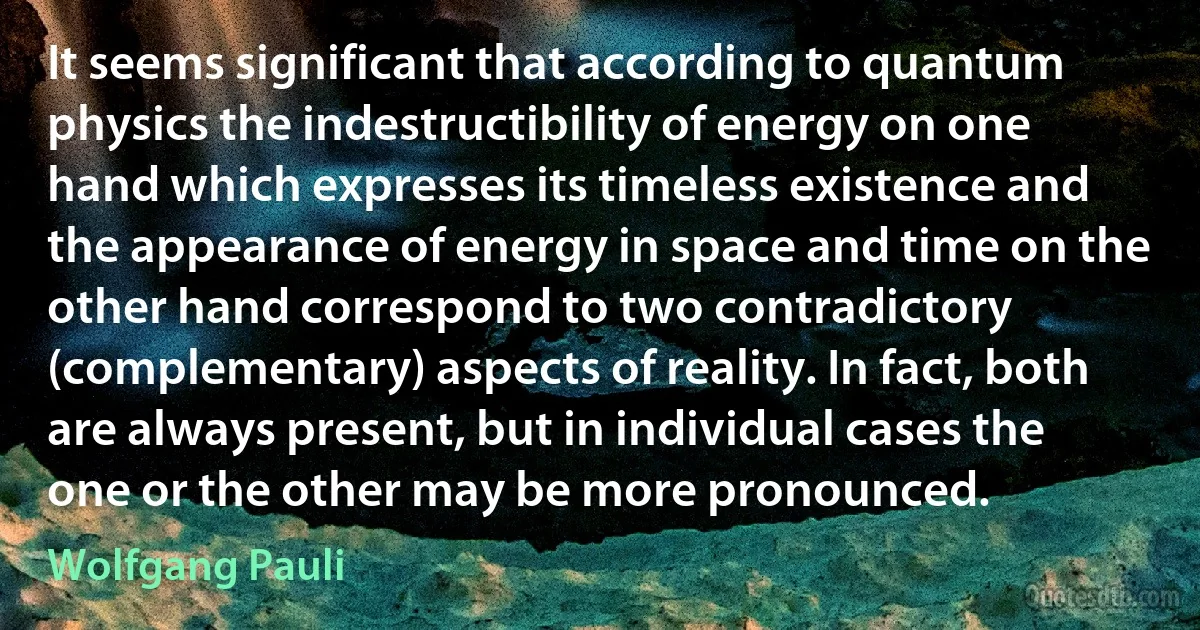Complementary Quotes - page 3
We have never heard Seurat, Cross, Luce, Van de Velde or indeed Van Rysselberghe or Angrand speak of dots. We have never seen them be preoccupied by Pointillism. Read these lines, dictated by Seurat to Jules Christophe, his biographer: 'Art is harmony; harmony is the analogy between opposites and between similar elements of tone, tint and line. By tone I mean light and dark; tint is red and its complementary: green, orange and its complementary: blue, yellow and its complementary: purple.. .The method of expression relies on the optical mixture of tones, tints and their reactions (shadows that follow very strict rules).

Paul Signac
The modern scientific worldview with all its hope for clarity and precision, has a "flipside," a complementary set of views which it generates as its train. And this is its misology, sophistry, its abandonment of rationality in the world of human significance. There is thus a quite literal type of schizophrenia in the world bequeathed to us by the Cartesians. It is, on the one hand, hyper-rational; it seeks to extend the purview of mathematical physics throughout the universe. On the other hand, it relegates the world in which the physicist himself dwells, the unique world of humanity and its communities, to the junkpile of the irrational. We who know so much are prohibited from knowing ourselves.

David Roochnik
A new view of the role of art and science in cartography is clearly needed. It is probably a mistake to view maps as objects that contain varied amounts of scientific or artistic content for which we must determine an appropriate balance (as both Keates, 1984, and Robinson, 1952, seem to, with Keates arguing for more art and Robinson for more science). Instead, it makes more sense to consider complementary artistic and scientific approaches to studying and improving maps, both of which can be applied to any given cartographic problem. The artistic approach is intuitive and holistic, achieving improvements through experience supplemented by critical examination (where critical examination implies expert appraisal of the results of our cartographic decision-making efforts). It draws on science in using perspective, understanding of human vision, color theory, and so on.

Alan MacEachren
Voluntary exchanges are by definition advantageous to their participants. Within this voluntary, mutually beneficial relationship, I give up an item I value less, for something I value more: a fee for the desired product or service. My trading partners, whose valuations are in complementary opposition to mine, reciprocate in kind. Ceteris paribus (all other things being equal), there's nothing wrong with my running a trade deficit with Costco, my hair stylist or my GTI dealer, as I do-just as long as I pay for my purchases. However, the data demonstrate that Americans, in general, are not paying for their purchases.

Ilana Mercer
I can quite understand why we cannot speak about the content of religion in an objectifying language. The fact that different religions try to express this content in quite distinct spiritual forms is no real objection. Perhaps we ought to look upon these different forms as complementary descriptions which, though they exclude one another, are needed to convey the rich possibilities flowing from man's relationship with the central order.

Niels Bohr
The problem that still remains to be solved is that of the orderable matrix, that needs the use of imagination... When the two components of a data table are orderable, the normal construction is the orderable matrix. Its permutations show the analogy and the complementary nature that exist between the algorithmic treatments and the graphical treatments.

Jacques Bertin
When Hobbes referred to the dire state of human beings in having ‘nasty, brutish and short' lives, he also pointed, in the same sentence, to the disturbing adversity of being ‘solitary'. Escape from isolation may not only be important for the quality of human life, it can also contribute powerfully to understanding and responding to the other deprivations from which human beings suffer. There is surely a basic strength here which is complementary to the engagement in which theories of justice are involved.

Amartya Sen
Being absolute, the supreme Principle is ipso facto infinite; the masculine body accentuates the first aspect, and the feminine body the second. On the basis of these two hypostatic aspects, the divine Principle is the source of all possible perfection; in other words, being the Absolute and the Infinite, It is necessarily also Perfection or the Good. Now each of the two bodies, the masculine and the feminine, manifests modes of perfection which their respective gender evokes by definition; indeed, all cosmic qualities are divided into two complementary groups: the rigorous and the gentle, the active and the passive, the contractive and the expansive. The human body is an image of Deliverance: now the liberating way maybe either "virile" or "feminine", although it is not possible to have a strict line of demarcation between the two modes, for man (homo, anthropos) is always man; the non-material being that was the primordial androgyne survives in each of us.

Frithjof Schuon
Be aware of doing your best to understand the ROOT in life, and realize the DIRECT and the INDIRECT are in fact a complementary WHOLE. It is to see things as they are and not to become attached to anything - to be unconscious meant to be innocent of the working of a relative (empirical) mind - where there is no abiding of thought anywhere on anything - this is being unbound. This not abiding anywhere is the root of our life.

Bruce Lee
GDP! The right concept of economy-wide output, accurately measured. The U.S. and the world rely on it to tell where we are in the business cycle and to estimate long-run growth. It is the centerpiece of an elaborate and indispensable system of social accounting, the national income and product accounts. This is surely the signal innovative achievement of the Commerce Department in the 20th century. I was fortunate to become an economist in the 1930's when Kuznets, Nathan, Gilbert, and Jaszi were creating this most important set of economic time series. In economic theory, macroeconomics was just beginning at the same time. Complementary, these two innovations deserve much credit for the improved performance of the economy in the second half of the century.

Simon Kuznets
Now, moral philosophers generally prefer to talk about virtues, or about (specific) duties, rights, and so on, rather than about moral images of the world. There are obvious reasons for this; nevertheless, I think that it is a mistake, and that Kant is profoundly right. What we require in moral philosophy is, first and foremost, a moral image of the world, or rather--since, here again, I am more of a pluralist than Kant--a number of complementary moral images of the world.

Hilary Putnam
Seurat read Delacroix's journals and made notes on his use of colour mixing in his paintings. Delacroix's puzzlement over why blobs of blue and yellow failed to produce green could have prepared Seurat to see in his French translation of Rood's Modern Chromatics an answer to the problem. He [Seurat] mentions in his letter to Fénéon that Ogden Rood's book had been brought to his attention in 1881 (the year it was published in France).. .w:Ogden Rood's chief lesson was to make clear the distinction between coloured lights and coloured pigments.. .However, as [w:Herbert, Robert L.|Herbert]] points out, in 1881 and 1882 Seurat's oil paintings were still in the Barbizon tradition and it was not until 1883 that his palette lightened and not until he started 'Grande Jatte|A Sunday Afternoon on the Island of La Grande Jatte|Grande Jatte' in 1884 that he started to use separate blobs of complementary colour in a clear, conscious manner..

Georges Seurat
Complementary to his is Thurber's remark that "humour is a kind of emotional chaos, told about quietly and calmly in retrospect". Emotional chaos is not pleasant; distillation of that chaos afterward may perhaps be pleasant in some of its aspects, and undoubtedly gives pleasure to others.

Robertson Davies



